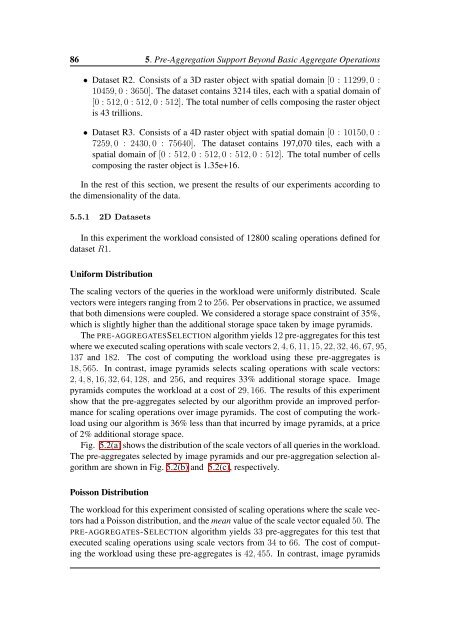Applying OLAP Pre-Aggregation Techniques to ... - Jacobs University
Applying OLAP Pre-Aggregation Techniques to ... - Jacobs University
Applying OLAP Pre-Aggregation Techniques to ... - Jacobs University
You also want an ePaper? Increase the reach of your titles
YUMPU automatically turns print PDFs into web optimized ePapers that Google loves.
86 5. <strong>Pre</strong>-<strong>Aggregation</strong> Support Beyond Basic Aggregate Operations<br />
• Dataset R2. Consists of a 3D raster object with spatial domain [0 : 11299, 0 :<br />
10459, 0 : 3650]. The dataset contains 3214 tiles, each with a spatial domain of<br />
[0 : 512, 0 : 512, 0 : 512]. The <strong>to</strong>tal number of cells composing the raster object<br />
is 43 trillions.<br />
• Dataset R3. Consists of a 4D raster object with spatial domain [0 : 10150, 0 :<br />
7259, 0 : 2430, 0 : 75640]. The dataset contains 197,070 tiles, each with a<br />
spatial domain of [0 : 512, 0 : 512, 0 : 512, 0 : 512]. The <strong>to</strong>tal number of cells<br />
composing the raster object is 1.35e+16.<br />
In the rest of this section, we present the results of our experiments according <strong>to</strong><br />
the dimensionality of the data.<br />
5.5.1 2D Datasets<br />
In this experiment the workload consisted of 12800 scaling operations defined for<br />
dataset R1.<br />
Uniform Distribution<br />
The scaling vec<strong>to</strong>rs of the queries in the workload were uniformly distributed. Scale<br />
vec<strong>to</strong>rs were integers ranging from 2 <strong>to</strong> 256. Per observations in practice, we assumed<br />
that both dimensions were coupled. We considered a s<strong>to</strong>rage space constraint of 35%,<br />
which is slightly higher than the additional s<strong>to</strong>rage space taken by image pyramids.<br />
The PRE-AGGREGATESSELECTION algorithm yields 12 pre-aggregates for this test<br />
where we executed scaling operations with scale vec<strong>to</strong>rs 2, 4, 6, 11, 15, 22, 32, 46, 67, 95,<br />
137 and 182. The cost of computing the workload using these pre-aggregates is<br />
18, 565. In contrast, image pyramids selects scaling operations with scale vec<strong>to</strong>rs:<br />
2, 4, 8, 16, 32, 64, 128, and 256, and requires 33% additional s<strong>to</strong>rage space. Image<br />
pyramids computes the workload at a cost of 29, 166. The results of this experiment<br />
show that the pre-aggregates selected by our algorithm provide an improved performance<br />
for scaling operations over image pyramids. The cost of computing the workload<br />
using our algorithm is 36% less than that incurred by image pyramids, at a price<br />
of 2% additional s<strong>to</strong>rage space.<br />
Fig. 5.2(a) shows the distribution of the scale vec<strong>to</strong>rs of all queries in the workload.<br />
The pre-aggregates selected by image pyramids and our pre-aggregation selection algorithm<br />
are shown in Fig. 5.2(b) and 5.2(c), respectively.<br />
Poisson Distribution<br />
The workload for this experiment consisted of scaling operations where the scale vec<strong>to</strong>rs<br />
had a Poisson distribution, and the mean value of the scale vec<strong>to</strong>r equaled 50. The<br />
PRE-AGGREGATES-SELECTION algorithm yields 33 pre-aggregates for this test that<br />
executed scaling operations using scale vec<strong>to</strong>rs from 34 <strong>to</strong> 66. The cost of computing<br />
the workload using these pre-aggregates is 42, 455. In contrast, image pyramids
















